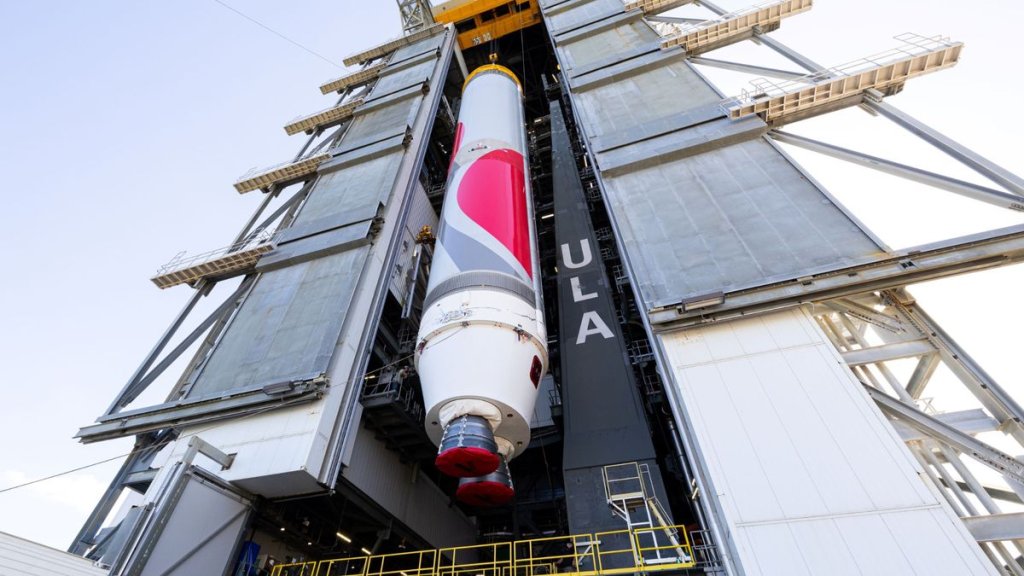
ULA Vulcan Centaur rocket’s 1st launch delayed to January 2024 (Image Credit: Space.com)
The premiere of the Space Coast’s newest launch vehicle, carrying a moon lander aiming for the first commercial touchdown, will likely slip to the beginning of 2024.
United Launch Alliance (ULA) performed a wet dress rehearsal (WDR) of the company’s new Vulcan Centaur rocket over the weekend, which includes loading propellant into the spacecraft and running through launch-day procedures up to the moments before engine ignition. That test, however, didn’t go to plan.
A social media post from ULA CEO Tory Bruno Sunday (Dec. 10), indicated the test, “ran the timeline long so we didn’t quite finish.” Vulcan’s first launch, which includes the rocket’s Centaur second stage, was scheduled for Dec. 24 from Cape Canaveral Space Force Station in coastal Florida. But the incomplete WDR means that window is likely out.
Related: See ULA assemble new Vulcan Centaur rocket for its 1st launch
According to Bruno, Sunday’s WDR experienced unspecified ground system issues the CEO described as “routine,” but an additional test would likely push the Christmas Eve launch window out of consideration.
#VulcanRocket WDR update: Vehicle performed well. Ground system had a couple of (routine) issues, (being corrected). Ran the timeline long so we didn’t quite finish. I’d like a FULL WDR before our first flight, so XMAS eve is likely out. Next Peregrine window is 8 Jan.December 10, 2023
“I’d like a FULL WDR before our first flight,” Bruno stated. The next window opens Jan. 8, and will last four days, the CEO clarified in a follow-up post. Each of those opportunities include an instantaneous launch window to accommodate the mission’s main payload: Astrobotic’s Peregrine lunar lander, headed for the moon.
Peregrine is a spacecraft contracted under the Commercial Lunar Payload Services (CLPS) initiative from NASA, which uses privately developed lunar vehicles to deliver scientific experiments and research equipment to the moon. Peregrine is considered to be one of the two lead vehicles right now to make the first-ever commercial landing on the moon. (No commercial vehicle has made it to the surface yet, despite several tries in recent years.)
Once in space, Peregrine will spend between 3 and 33 days on its journey between Earth and the moon, and another 4 to 25 days in lunar orbit, according to NASA. Peregrine will target a strange, swirly landing site in Sinus Viscositatis (the Bay of Stickiness), northeast of the moon’s Ocean of Storms and the approximate Apollo 12 landing area with NASA astronauts in 1969.

Also onboard will be a payload from space memorial company Celestis. Known for memorial flights of DNA into outer space, Celestis has included a number of recognizable honorees to the upcoming Vulcan-launched mission, which it has appropriately named “Enterprise.”
Among those DNA samples taking part in the flight are cast members of the original “Star Trek” television series — Nichelle Nichols, DeForest Kelley and James Doohan — as well as series creator Gene Roddenberry, and his wife and recurring series actor Majel Barrett Roddenberry.
According to the Celestis website, Enterprise will be the company’s first “Voyager Service” option flown for its customers, which launches the DNA samples into interplanetary space.
The delay in Vulcan’s launch is another in a series for the rocket, which was expected to launch earlier in 2023. An explosion during the testing of Vulcan’s Centaur stage in March ultimately pushed the rocket’s debut to the end of the year. This latest shift in launch windows also means ULA will have only launched three rockets in 2023, compared to a total of eight launches in 2022. ULA’s main competitor, SpaceX, in contrast, has completed over 90 launches this year.
Vulcan’s Dec. 24 launch was scheduled for 1:49 a.m. EST (0649 GMT). It is unclear what time the rocket’s instantaneous window opens for the Jan. 8 attempt. Bruno did indicate in a social media post that those details would be forthcoming.
Astrobotic isn’t the only private moon company targeting a landing in the near future. Intuitive Machines recently said its own launch of its NASA-funded IM-1 mission will fly with SpaceX as soon as mid-January 2024. It is unclear which of these two missions (IM-1 or Peregrine) is targeted to land first on the moon, given the shifting development timelines.








